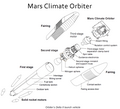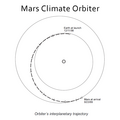
Mars Climate Orbiter
The Mars Climate Orbiter (formerly the Mars Surveyor '98 Orbiter) was a robotic space probe launched by NASA on December 11, 1998, to study the Martian climate, Martian atmosphere, and surface changes and to act as the communications relay in the Mars Surveyor '98 program for Mars Polar Lander. However, on September 23, 1999, communication with the spacecraft was permanently lost as it went into orbital insertion. The spacecraft encountered Mars on a trajectory that brought it too close to the planet, and it was either destroyed in the atmosphere or escaped the planet's vicinity and entered an orbit around the Sun.[2] An investigation attributed the failure to a measurement mismatch between two measurement systems: SI units (metric) by NASA and US customary units by spacecraft builder Lockheed Martin.[3]
Mission background[edit]
History[edit]
After the loss of Mars Observer and the onset of the rising costs associated with the future International Space Station, NASA began seeking less expensive, smaller probes for scientific interplanetary missions. In 1994, the Panel on Small Spacecraft Technology was established to set guidelines for future miniature spacecraft. The panel determined that the new line of miniature spacecraft should be under 1000 kg (2200 pounds) with highly focused instrumentation.[4] In 1995, a new Mars Surveyor program began as a set of missions designed with limited objectives, low costs, and frequent launches. The first mission in the new program was Mars Global Surveyor, launched in 1996 to map Mars and provide geologic data using instruments intended for Mars Observer.[5] Following Mars Global Surveyor, Mars Climate Orbiter carried two instruments, one originally intended for Mars Observer, to study the climate and weather of Mars.
The primary science objectives of the mission included:[6]



